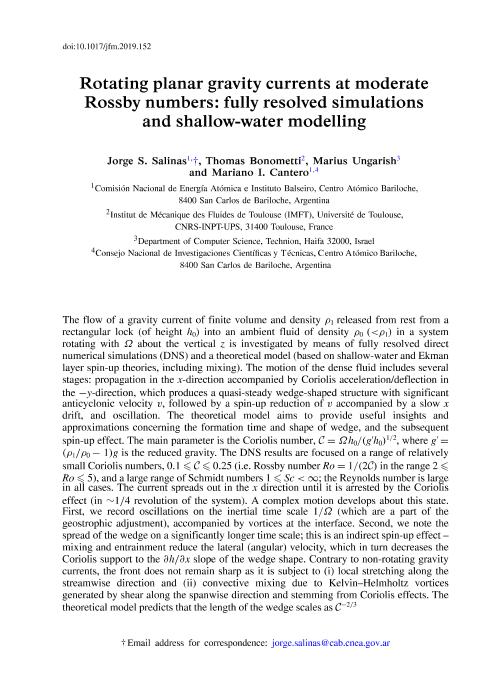Artículo
Rotating planar gravity currents at moderate Rossby numbers: Fully resolved simulations and shallow-water modelling
Fecha de publicación:
05/2019
Editorial:
Cambridge University Press
Revista:
Journal of Fluid Mechanics
ISSN:
0022-1120
Idioma:
Inglés
Tipo de recurso:
Artículo publicado
Clasificación temática:
Resumen
The flow of a gravity current of finite volume and density ρ 1 released from rest from a rectangular lock (of height h 0 ) into an ambient fluid of density ρ 1 (< ρ 1 ) in a system rotating with Ω about the vertical z is investigated by means of fully resolved direct numerical simulations (DNS) and a theoretical model (based on shallow-water and Ekman layer spin-up theories, including mixing). The motion of the dense fluid includes several stages: propagation in the x-direction accompanied by Coriolis acceleration/deflection in the -y-direction, which produces a quasi-steady wedge-shaped structure with significant anticyclonic velocity v, followed by a spin-up reduction of v accompanied by a slow x drift, and oscillation. The theoretical model aims to provide useful insights and approximations concerning the formation time and shape of wedge, and the subsequent spin-up effect. The main parameter is the Coriolis number, C = Ωh 0 /(g′h 0 ) 1/2 , where g′ =(ρ 1 /ρ 0 -1)g is the reduced gravity. The DNS results are focused on a range of relatively small Coriolis numbers, 0.1 ≤ C ≤ 0.25 (i.e. Rossby number Ro = 1=(2C) in the range 2 ≤ Ro ≤ 5), and a large range of Schmidt numbers 1≤Sc<∞; the Reynolds number is large in all cases. The current spreads out in the x direction until it is arrested by the Coriolis effect (in ∼1/4 revolution of the system). A complex motion develops about this state. First, we record oscillations on the inertial time scale 1/Ω (which are a part of the geostrophic adjustment), accompanied by vortices at the interface. Second, we note the spread of the wedge on a significantly longer time scale; this is an indirect spin-up effect - mixing and entrainment reduce the lateral (angular) velocity, which in turn decreases the Coriolis support to the ∂h/∂x slope of the wedge shape. Contrary to non-rotating gravity currents, the front does not remain sharp as it is subject to (i) local stretching along the streamwise direction and (ii) convective mixing due to Kelvin-Helmholtz vortices generated by shear along the spanwise direction and stemming from Coriolis effects. The theoretical model predicts that the length of the wedge scales as C -2/3 (in contrast to the Rossby radius ∈1/C which is relevant for large C; and in contrast to C -1/2 for the axisymmetric lens).
Palabras clave:
GRAVITY CURRENTS
,
ROTATING FLOWS
Archivos asociados
Licencia
Identificadores
Colecciones
Articulos(CCT - PATAGONIA NORTE)
Articulos de CTRO.CIENTIFICO TECNOL.CONICET - PATAGONIA NORTE
Articulos de CTRO.CIENTIFICO TECNOL.CONICET - PATAGONIA NORTE
Citación
Salinas, Jorge Sebastián; Bonometti, Thomas; Ungarish, Marius; Cantero, Mariano Ignacio; Rotating planar gravity currents at moderate Rossby numbers: Fully resolved simulations and shallow-water modelling; Cambridge University Press; Journal of Fluid Mechanics; 867; 5-2019; 114-145
Compartir
Altmétricas




